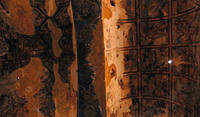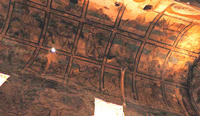You are in: Middle East -> Jordan -> Quseir Amra, and traditional search or Image Gallery will yield results of this site only
Quseir Amra
| Site number: | 327 |
|
| Type of site: | Cultural | |
| Date: | 8th century | |
| Date of Inscription: | 1985 | |
| Location: | Middle East, Jordan, Eastern desert – Az Zarqa' Governorate | |
Up to 75 images are shown here. Click on each for more details or on Image Gallery for more images.
| Description: | This remarkably well-preserved desert castle, erected in the early 8th century, was both a fortress with barracks and the Umayyad caliphs’ residence. This petite pleasure palace’s exceptional features are composed of the reception hall and the hammam, both luxuriously ornamented with emblematic murals that mirror the period’s secular art. --WHMNet paraphrase from the description at WHC Site, where additional information is available. For 360 degree imaging of this site, click here. | |
| Qasr Amra (Arabic: قصر عمرة) is the best-known of the desert castles located in present-day eastern Jordan. The castle was built early in the 8th century (probably between 711 and 715) by the Umayyad caliph Walid I whose dominance of the region was rising at the time. The castle is thus one of the most important examples of early Islamic art and architecture. Fresco from Qasr Amra, Pergamon Museum, Berlin: The castle, which was used as a retreat by the caliph or his princes for sport and pleasure, is lined with frescos that depict hunting scenes (of mammals long since hunted to extinction in the Middle East), fruit and nude women. The castle also contains a bath complex with a triple-vaulted ceiling that shows a Roman influence. Today Qasr Amra is in a poorer condition than the other desert castles, with graffiti damaging some frescos. However, restoration projects are underway. The well and water system can be seen. Abandoned structure was re-discovered by Alois Musil in 1898. The castle was made a UNESCO World Heritage Site in 1985 under criteria i), iii), and iv) ("masterpiece of human creative genius", "unique or at least exceptional testimony to a cultural tradition" and "an outstanding example of a type of building, architectural or technological ensemble or landscape which illustrates a significant stage in human history"). --Wikipedia. Text is available under the Creative Commons Attribution-ShareAlike License. For 360 degree imaging of this site, click here. | ||
| Source: | http://whc.unesco.org/en/list/327 | |
| Reference: | 1. UNESCO World Heritage Center, Site Page. | |

























































